light MAZDA MODEL 6 2005 (in English) User Guide
[x] Cancel search | Manufacturer: MAZDA, Model Year: 2005, Model line: MODEL 6, Model: MAZDA MODEL 6 2005Pages: 340, PDF Size: 3.73 MB
Page 42 of 340
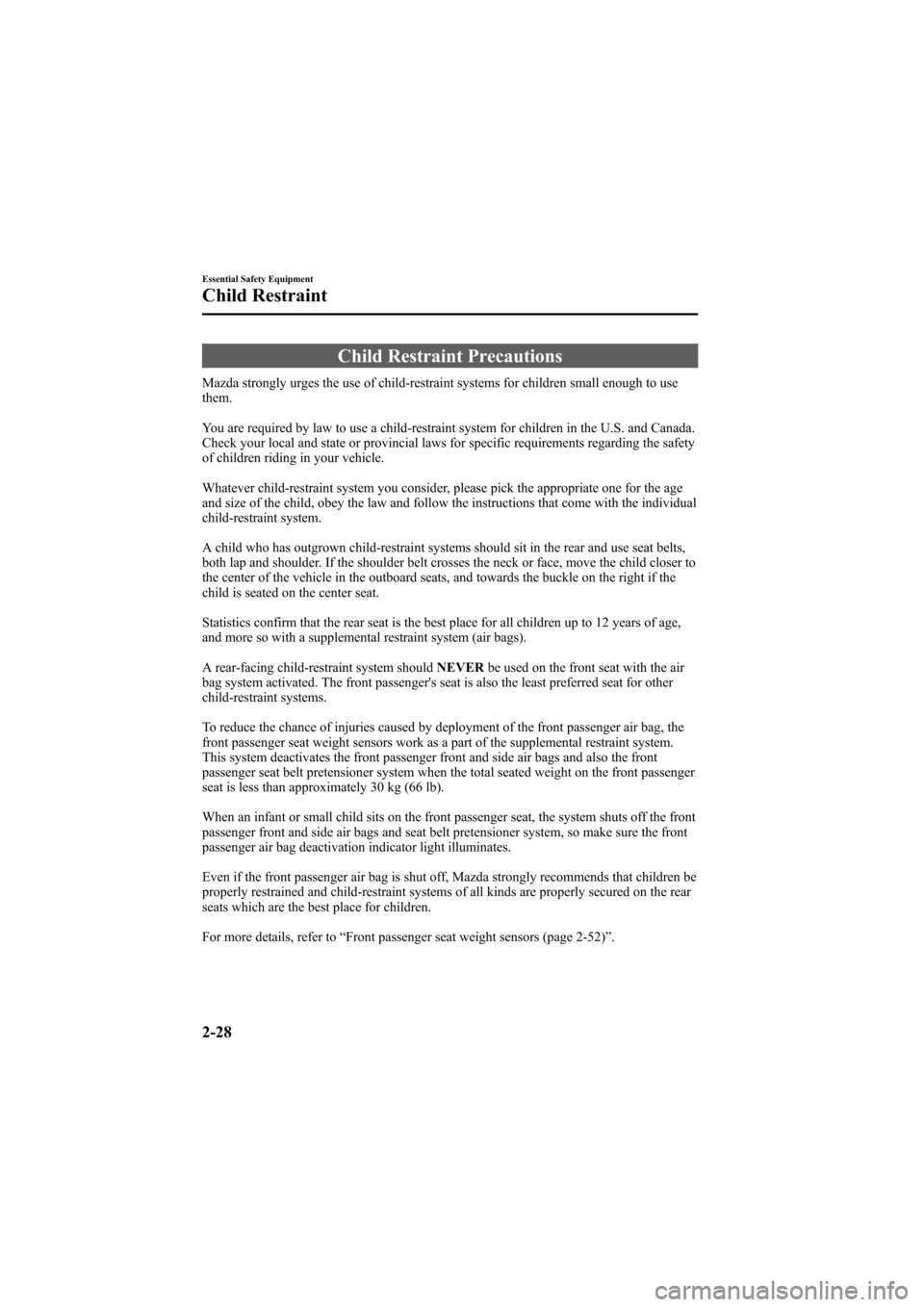
Black plate (42,1)
Child Restraint Precautions
Mazda strongly urges the use of child-restraint systems for children small enough to use
them.
You are required by law to use a child-restraint system for children in the U.S. and Canada.
Check your local and state or provincial laws for specific requirements regarding the safety
of children riding in your vehicle.
Whatever child-restraint system you consider, please pick the appropriate one for the age
and size of the child, obey the law and follow the instructions that come with the individual
child-restraint system.
A child who has outgrown child-restraint systems should sit in the rear and use seat belts,
both lap and shoulder. If the shoulder belt crosses the neck or face, move the child closer to
the center of the vehicle in the outboard seats, and towards the buckle on the right if the
child is seated on the center seat.
Statistics confirm that the rear seat is the best place for all children up to 12 years of age,
and more so with a supplemental restraint system (air bags).
A rear-facing child-restraint system shouldNEVERbe used on the front seat with the air
bag system activated. The front passenger's seat is also the least preferred seat for other
child-restraint systems.
To reduce the chance of injuries caused by deployment of the front passenger air bag, the
front passenger seat weight sensors work as a part of the supplemental restraint system.
This system deactivates the front passenger front and side air bags and also the front
passenger seat belt pretensioner system when the total seated weight on the front passenger
seat is less than approximately 30 kg (66 lb).
When an infant or small child sits on the front passenger seat, the system shuts off the front
passenger front and side air bags and seat belt pretensioner system, so make sure the front
passenger air bag deactivation indicator light illuminates.
Even if the front passenger air bag is shut off, Mazda strongly recommends that children be
properly restrained and child-restraint systems of all kinds are properly secured on the rear
seats which are the best place for children.
For more details, refer to“Front passenger seat weight sensors (page 2-52)”.
2-28
Essential Safety Equipment
Child Restraint
Mazda6_8T56-EC-04G_Edition2 Page42
Monday, November 15 2004 4:32 PM
Form No.8T56-EC-04G
Page 43 of 340
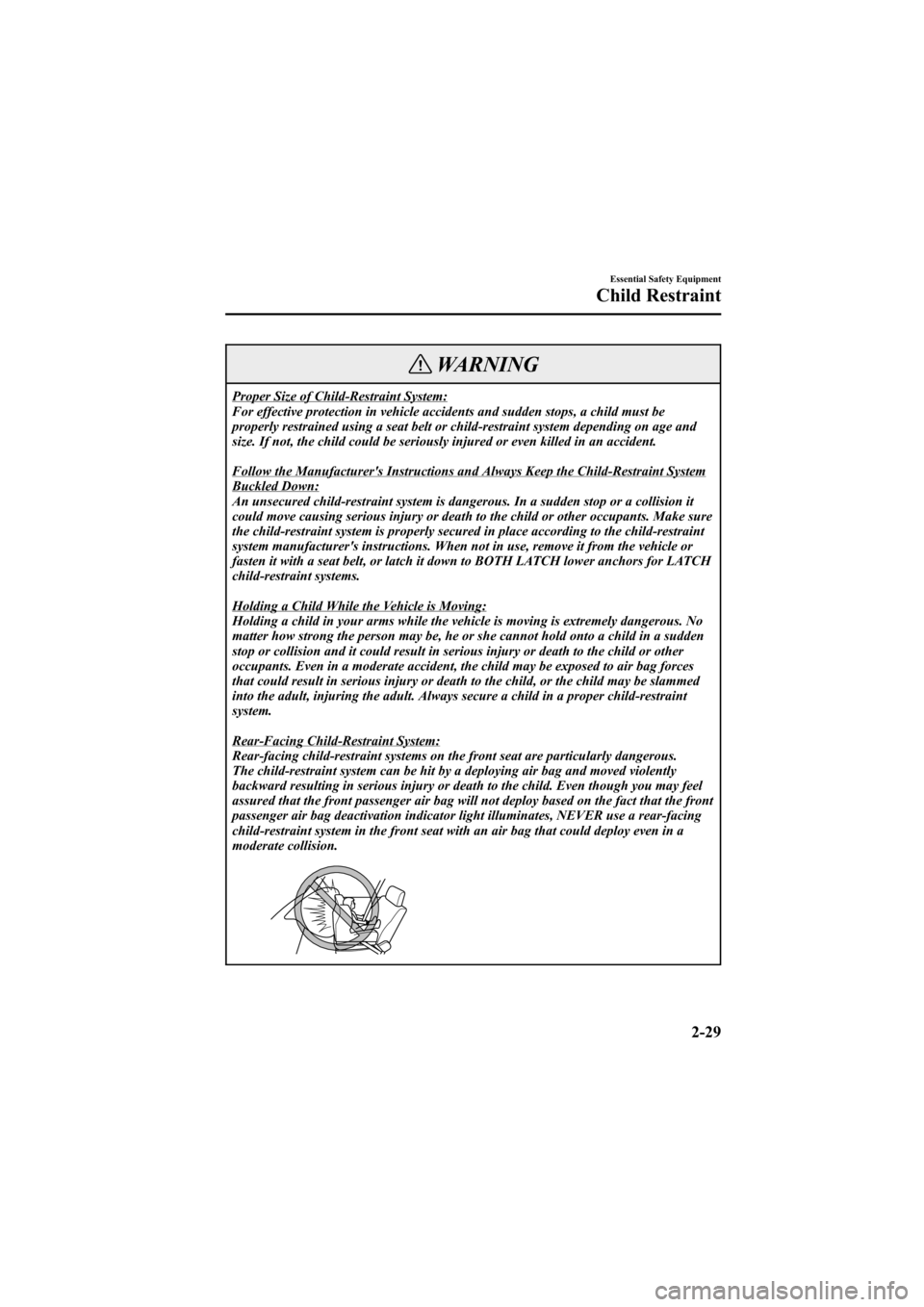
Black plate (43,1)
WARNING
Proper Size of Child-Restraint System:
For effective protection in vehicle accidents and sudden stops, a child must be
properly restrained using a seat belt or child-restraint system depending on age and
size. If not, the child could be seriously injured or even killed in an accident.
Follow the Manufacturer's Instructions and Always Keep the Child-Restraint SystemBuckled Down:
An unsecured child-restraint system is dangerous. In a sudden stop or a collision it
could move causing serious injury or death to the child or other occupants. Make sure
the child-restraint system is properly secured in place according to the child-restraint
system manufacturer's instructions. When not in use, remove it from the vehicle or
fasten it with a seat belt, or latch it down to BOTH LATCH lower anchors for LATCH
child-restraint systems.
Holding a Child While the Vehicle is Moving:
Holding a child in your arms while the vehicle is moving is extremely dangerous. No
matter how strong the person may be, he or she cannot hold onto a child in a sudden
stop or collision and it could result in serious injury or death to the child or other
occupants. Even in a moderate accident, the child may be exposed to air bag forces
that could result in serious injury or death to the child, or the child may be slammed
into the adult, injuring the adult. Always secure a child in a proper child-restraint
system.
Rear-Facing Child-Restraint System:
Rear-facing child-restraint systems on the front seat are particularly dangerous.
The child-restraint system can be hit by a deploying air bag and moved violently
backward resulting in serious injury or death to the child. Even though you may feel
assured that the front passenger air bag will not deploy based on the fact that the front
passenger air bag deactivation indicator light illuminates, NEVER use a rear-facing
child-restraint system in the front seat with an air bag that could deploy even in a
moderate collision.
Essential Safety Equipment
Child Restraint
2-29
Mazda6_8T56-EC-04G_Edition2 Page43
Monday, November 15 2004 4:32 PM
Form No.8T56-EC-04G
Page 44 of 340
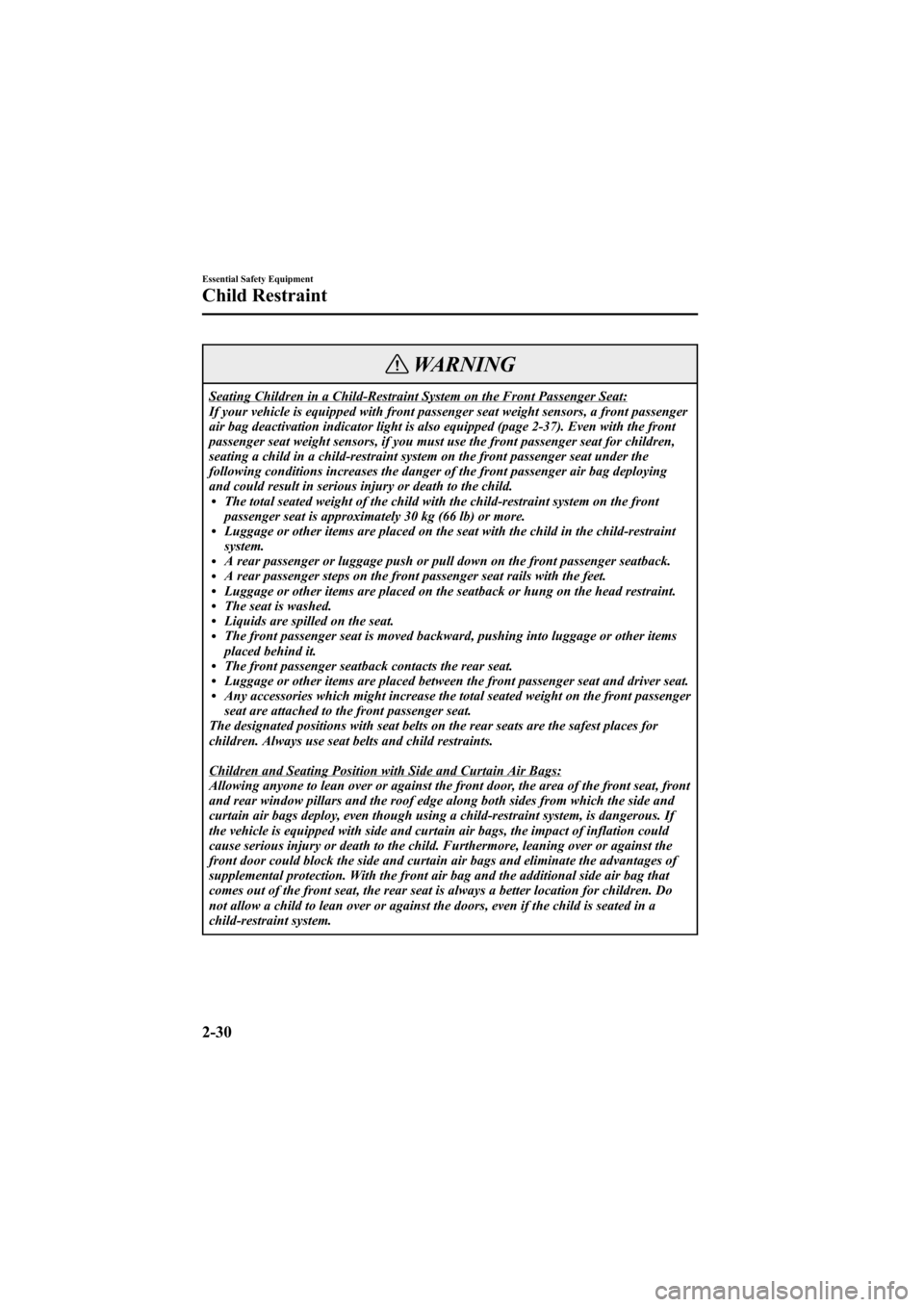
Black plate (44,1)
WARNING
Seating Children in a Child-Restraint System on the Front Passenger Seat:
If your vehicle is equipped with front passenger seat weight sensors, a front passenger
air bag deactivation indicator light is also equipped (page 2-37). Even with the front
passenger seat weight sensors, if you must use the front passenger seat for children,
seating a child in a child-restraint system on the front passenger seat under the
following conditions increases the danger of the front passenger air bag deploying
and could result in serious injury or death to the child.
lThe total seated weight of the child with the child-restraint system on the front
passenger seat is approximately 30 kg (66 lb) or more.
lLuggage or other items are placed on the seat with the child in the child-restraint
system.
lA rear passenger or luggage push or pull down on the front passenger seatback.lA rear passenger steps on the front passenger seat rails with the feet.lLuggage or other items are placed on the seatback or hung on the head restraint.lThe seat is washed.lLiquids are spilled on the seat.lThe front passenger seat is moved backward, pushing into luggage or other items
placed behind it.
lThe front passenger seatback contacts the rear seat.lLuggage or other items are placed between the front passenger seat and driver seat.lAny accessories which might increase the total seated weight on the front passenger
seat are attached to the front passenger seat.
The designated positions with seat belts on the rear seats are the safest places for
children. Always use seat belts and child restraints.
Children and Seating Position with Side and Curtain Air Bags:
Allowing anyone to lean over or against the front door, the area of the front seat, front
and rear window pillars and the roof edge along both sides from which the side and
curtain air bags deploy, even though using a child-restraint system, is dangerous. If
the vehicle is equipped with side and curtain air bags, the impact of inflation could
cause serious injury or death to the child. Furthermore, leaning over or against the
front door could block the side and curtain air bags and eliminate the advantages of
supplemental protection. With the front air bag and the additional side air bag that
comes out of the front seat, the rear seat is always a better location for children. Do
not allow a child to lean over or against the doors, even if the child is seated in a
child-restraint system.
2-30
Essential Safety Equipment
Child Restraint
Mazda6_8T56-EC-04G_Edition2 Page44
Monday, November 15 2004 4:32 PM
Form No.8T56-EC-04G
Page 52 of 340
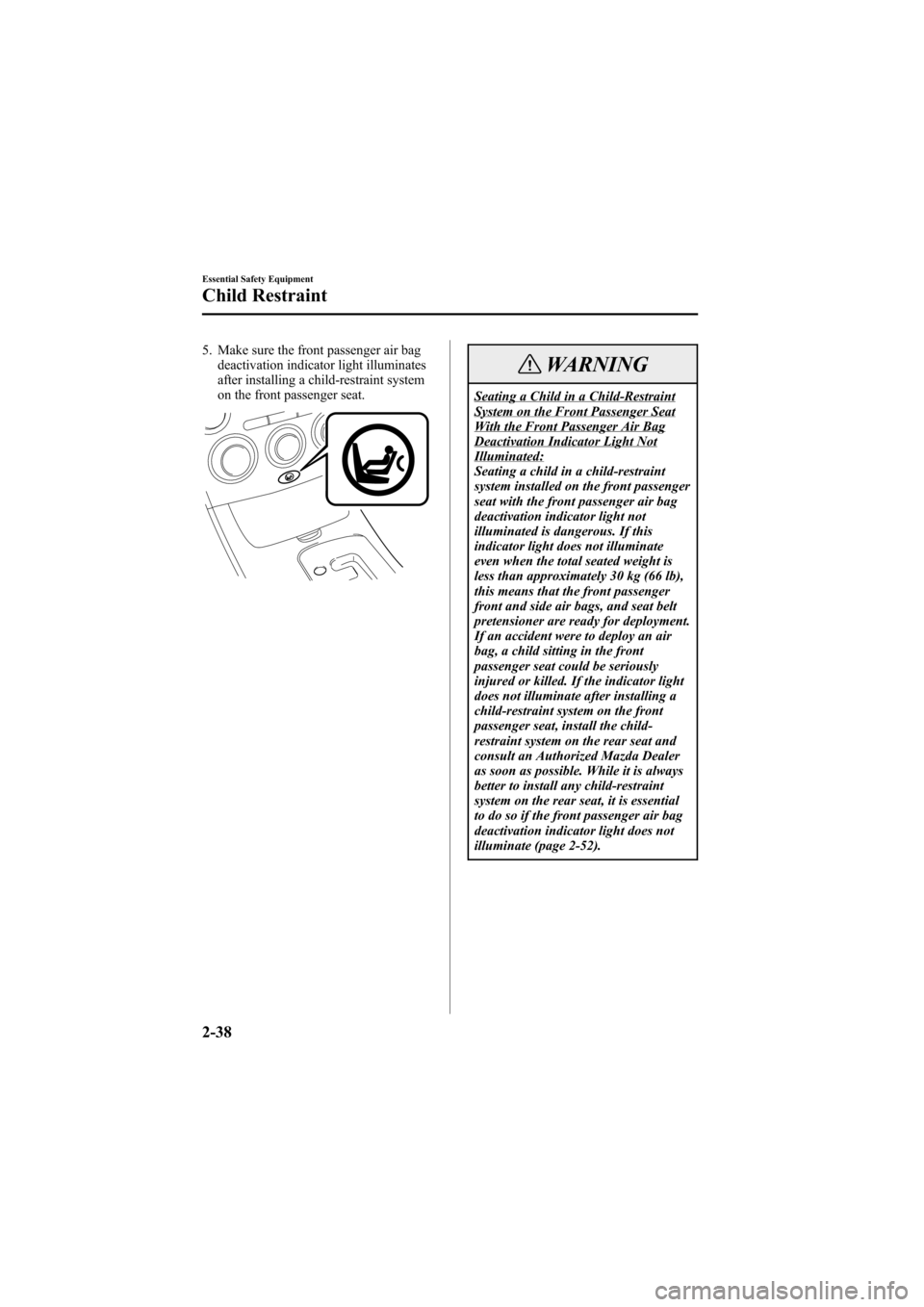
Black plate (52,1)
5. Make sure the front passenger air bag
deactivation indicator light illuminates
after installing a child-restraint system
on the front passenger seat.
WARNING
Seating a Child in a Child-RestraintSystem on the Front Passenger SeatWith the Front Passenger Air BagDeactivation Indicator Light NotIlluminated:
Seating a child in a child-restraint
system installed on the front passenger
seat with the front passenger air bag
deactivation indicator light not
illuminated is dangerous. If this
indicator light does not illuminate
even when the total seated weight is
less than approximately 30 kg (66 lb),
this means that the front passenger
front and side air bags, and seat belt
pretensioner are ready for deployment.
If an accident were to deploy an air
bag, a child sitting in the front
passenger seat could be seriously
injured or killed. If the indicator light
does not illuminate after installing a
child-restraint system on the front
passenger seat, install the child-
restraint system on the rear seat and
consult an Authorized Mazda Dealer
as soon as possible. While it is always
better to install any child-restraint
system on the rear seat, it is essential
to do so if the front passenger air bag
deactivation indicator light does not
illuminate (page 2-52).
2-38
Essential Safety Equipment
Child Restraint
Mazda6_8T56-EC-04G_Edition2 Page52
Monday, November 15 2004 4:32 PM
Form No.8T56-EC-04G
Page 54 of 340
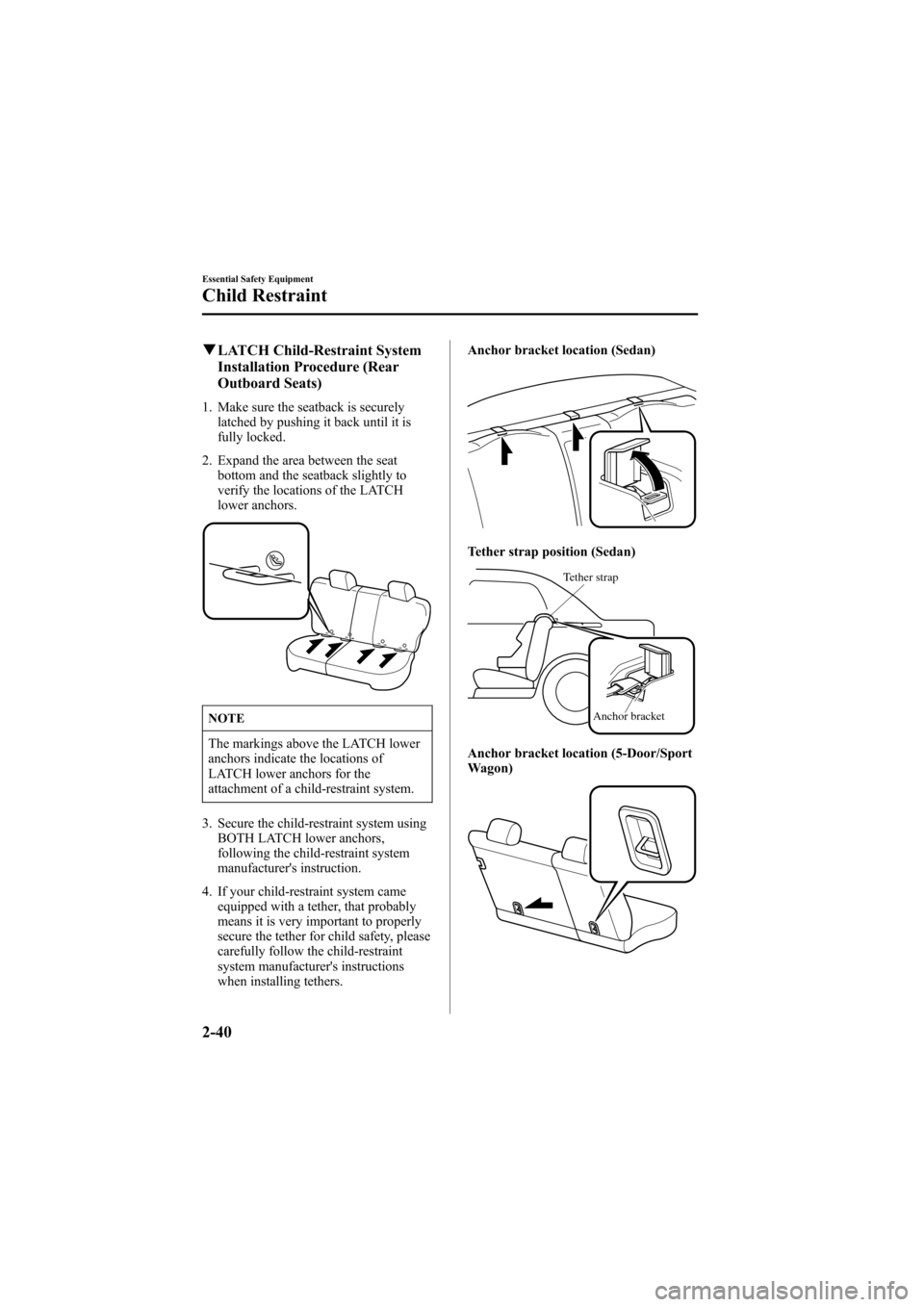
Black plate (54,1)
qLATCH Child-Restraint System
Installation Procedure (Rear
Outboard Seats)
1. Make sure the seatback is securely
latched by pushing it back until it is
fully locked.
2. Expand the area between the seat
bottom and the seatback slightly to
verify the locations of the LATCH
lower anchors.
NOTE
The markings above the LATCH lower
anchors indicate the locations of
LATCH lower anchors for the
attachment of a child-restraint system.
3. Secure the child-restraint system using
BOTH LATCH lower anchors,
following the child-restraint system
manufacturer's instruction.
4. If your child-restraint system came
equipped with a tether, that probably
means it is very important to properly
secure the tether for child safety, please
carefully follow the child-restraint
system manufacturer's instructions
when installing tethers.Anchor bracket location (Sedan)
Tether strap position (Sedan)
Tether strap
Anchor bracket
Anchor bracket location (5-Door/Sport
Wagon)
2-40
Essential Safety Equipment
Child Restraint
Mazda6_8T56-EC-04G_Edition2 Page54
Monday, November 15 2004 4:32 PM
Form No.8T56-EC-04G
Page 56 of 340
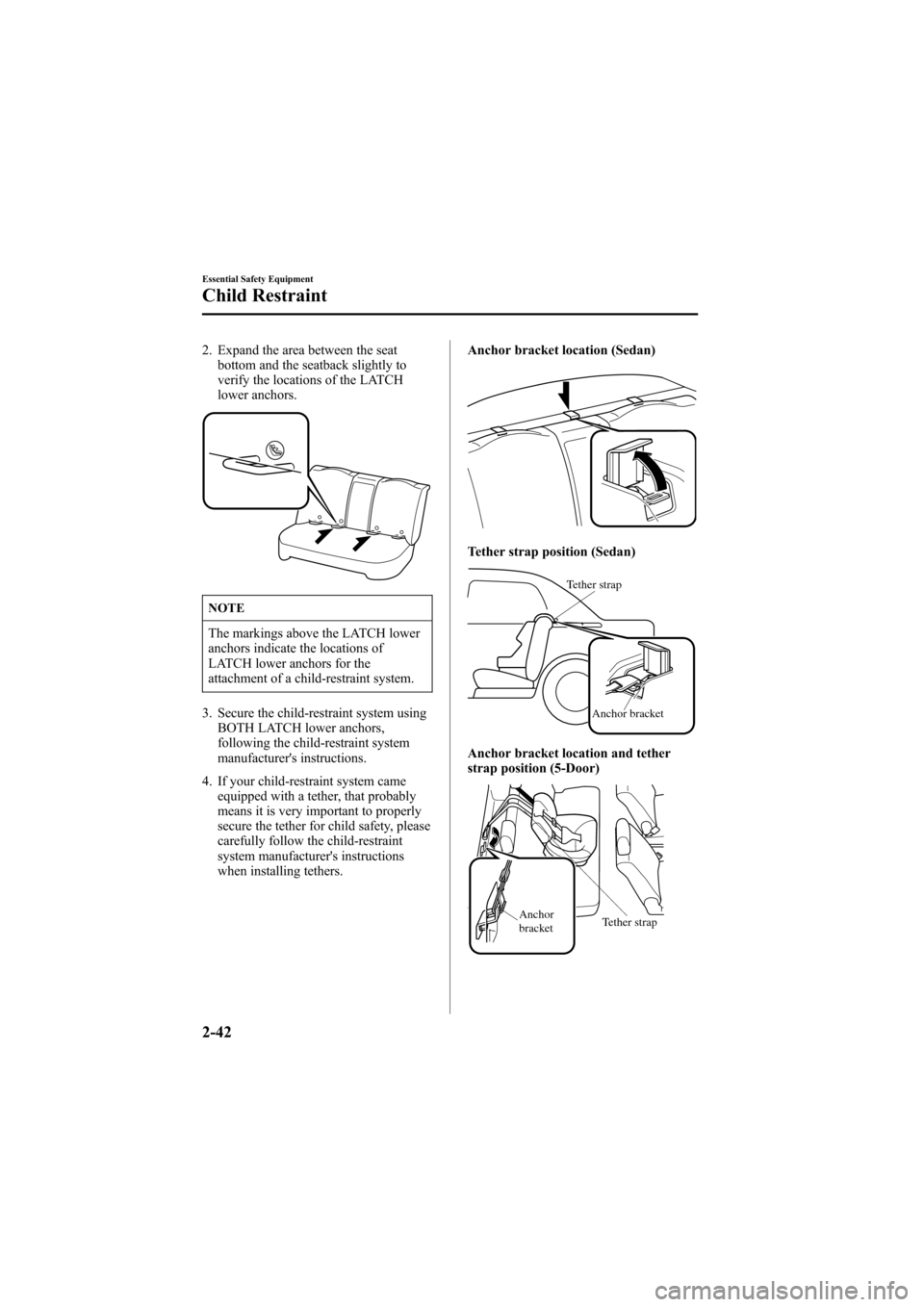
Black plate (56,1)
2. Expand the area between the seat
bottom and the seatback slightly to
verify the locations of the LATCH
lower anchors.
NOTE
The markings above the LATCH lower
anchors indicate the locations of
LATCH lower anchors for the
attachment of a child-restraint system.
3. Secure the child-restraint system using
BOTH LATCH lower anchors,
following the child-restraint system
manufacturer's instructions.
4. If your child-restraint system came
equipped with a tether, that probably
means it is very important to properly
secure the tether for child safety, please
carefully follow the child-restraint
system manufacturer's instructions
when installing tethers.Anchor bracket location (Sedan)
Tether strap position (Sedan)
Tether strap
Anchor bracket
Anchor bracket location and tether
strap position (5-Door)
Tether strap Anchor
bracket
2-42
Essential Safety Equipment
Child Restraint
Mazda6_8T56-EC-04G_Edition2 Page56
Monday, November 15 2004 4:32 PM
Form No.8T56-EC-04G
Page 59 of 340

Black plate (59,1)
WARNING
Air Bags without Seat Belts:
Depending only on the air bags for protection during an accident is dangerous. Alone,
air bags may not prevent serious injuries. The appropriate air bags can be expected to
inflate only in collisions with frontal, near frontal or side forces that are at least
moderate. Vehicle occupants should always wear seat belts.
Child in the Front Seat:
Placing a child, 12 years or under, in the front seat is dangerous. The child could be
hit by a deploying air bag and be seriously injured or even killed. A sleeping child is
more likely to lean against the door and be hit by the side air bag in a moderate, right-
side collision. Whenever possible, always secure a child 12 years and under on the
rear seat with an appropriate child-restraint system for the child's age and size.
Rear-Facing Child-Restraint System:
Rear-facing child-restraint systems on the front seat are particularly dangerous.
The child-restraint system can be hit by a deploying air bag and moved violently
backward resulting in serious injury or death to the child. Even though you may feel
assured that the front passenger air bag will not deploy based on the fact that the front
passenger air bag deactivation indicator light illuminates, NEVER use a rear-facing
child-restraint system in the front seat with an air bag that could deploy even in a
moderate collision.
Seating Position with Front Air Bags:
Sitting too close to the air bag modules or placing hands or feet on them is extremely
dangerous. Front Air bags inflate with great force and speed. Serious injuries could
occur if someone is too close. The driver should always hold onto only the rim of the
steering wheel. The front seat passenger should keep both feet on the floor. Front seat
occupants should adjust their seats as far back as possible and always sit upright
against the seatbacks with seat belts worn properly.
Essential Safety Equipment
SRS Air Bags
2-45
Mazda6_8T56-EC-04G_Edition2 Page59
Monday, November 15 2004 4:32 PM
Form No.8T56-EC-04G
Page 62 of 340
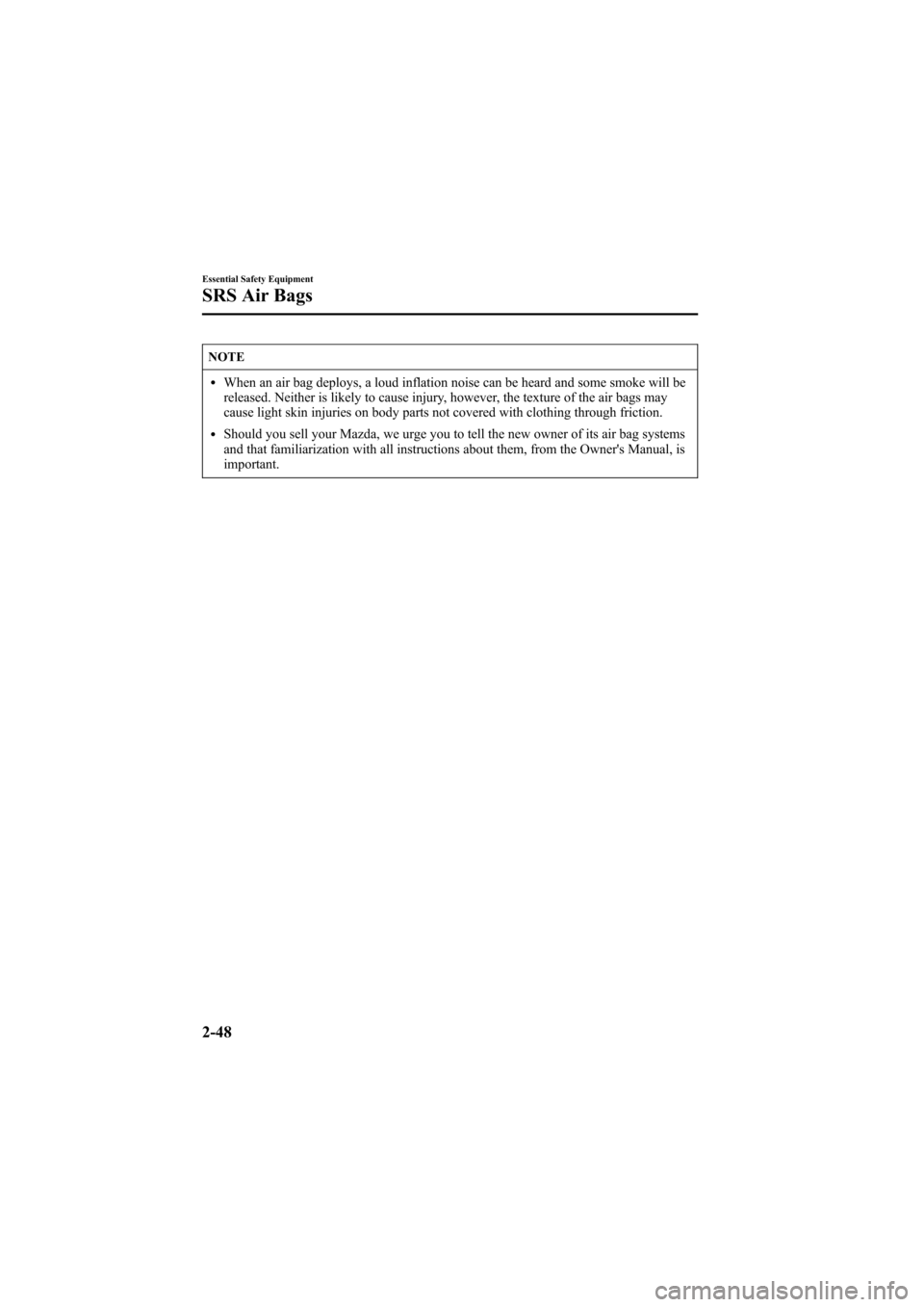
Black plate (62,1)
NOTE
lWhen an air bag deploys, a loud inflation noise can be heard and some smoke will be
released. Neither is likely to cause injury, however, the texture of the air bags may
cause light skin injuries on body parts not covered with clothing through friction.
lShould you sell your Mazda, we urge you to tell the new owner of its air bag systems
and that familiarization with all instructions about them, from the Owner's Manual, is
important.
2-48
Essential Safety Equipment
SRS Air Bags
Mazda6_8T56-EC-04G_Edition2 Page62
Monday, November 15 2004 4:32 PM
Form No.8T56-EC-04G
Page 64 of 340
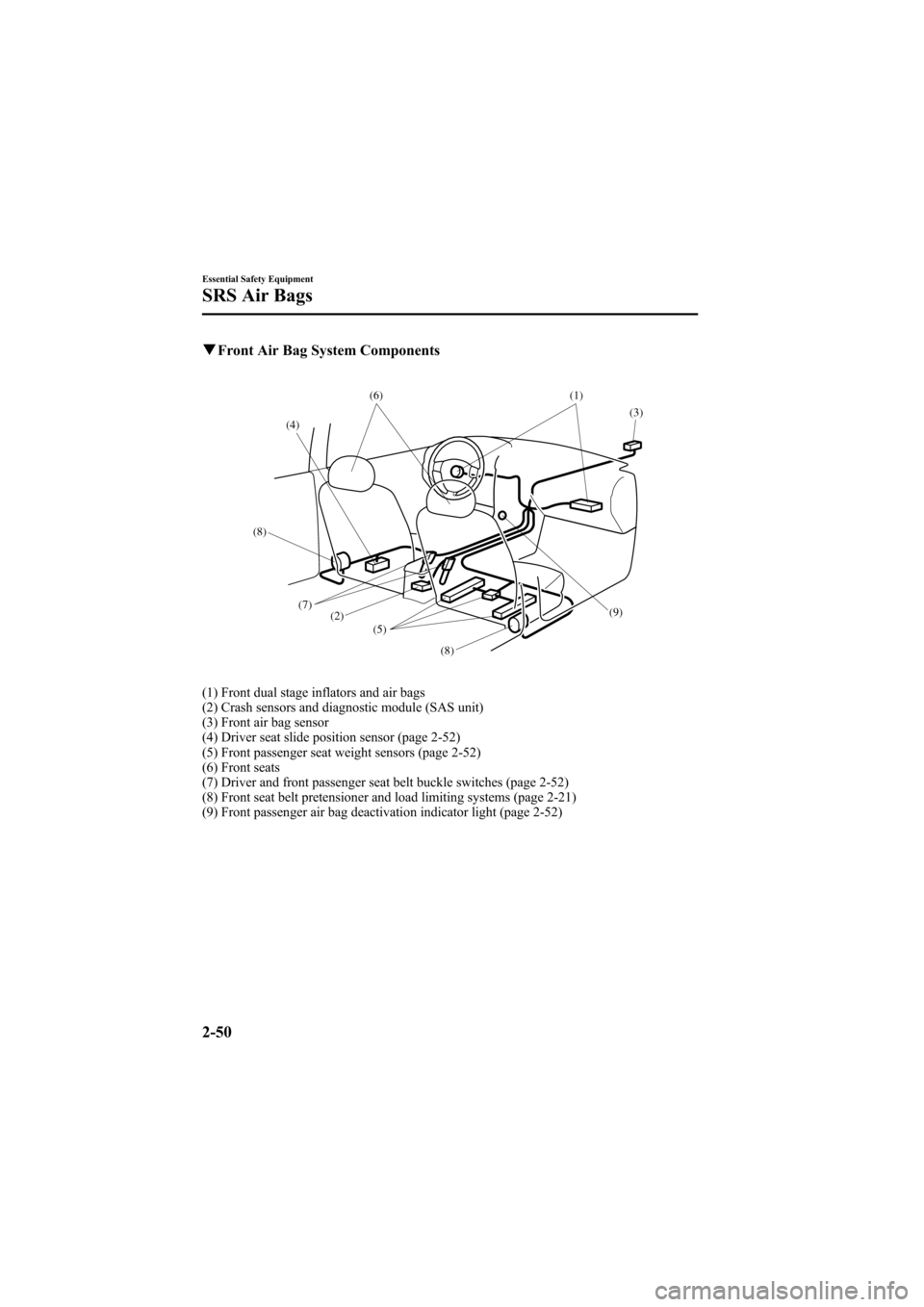
Black plate (64,1)
qFront Air Bag System Components
(4)
(8)
(7)
(5)
(8) (2)(9)(3) (1) (6)
(1) Front dual stage inflators and air bags
(2) Crash sensors and diagnostic module (SAS unit)
(3) Front air bag sensor
(4) Driver seat slide position sensor (page 2-52)
(5) Front passenger seat weight sensors (page 2-52)
(6) Front seats
(7) Driver and front passenger seat belt buckle switches (page 2-52)
(8) Front seat belt pretensioner and load limiting systems (page 2-21)
(9) Front passenger air bag deactivation indicator light (page 2-52)
2-50
Essential Safety Equipment
SRS Air Bags
Mazda6_8T56-EC-04G_Edition2 Page64
Monday, November 15 2004 4:32 PM
Form No.8T56-EC-04G
Page 66 of 340
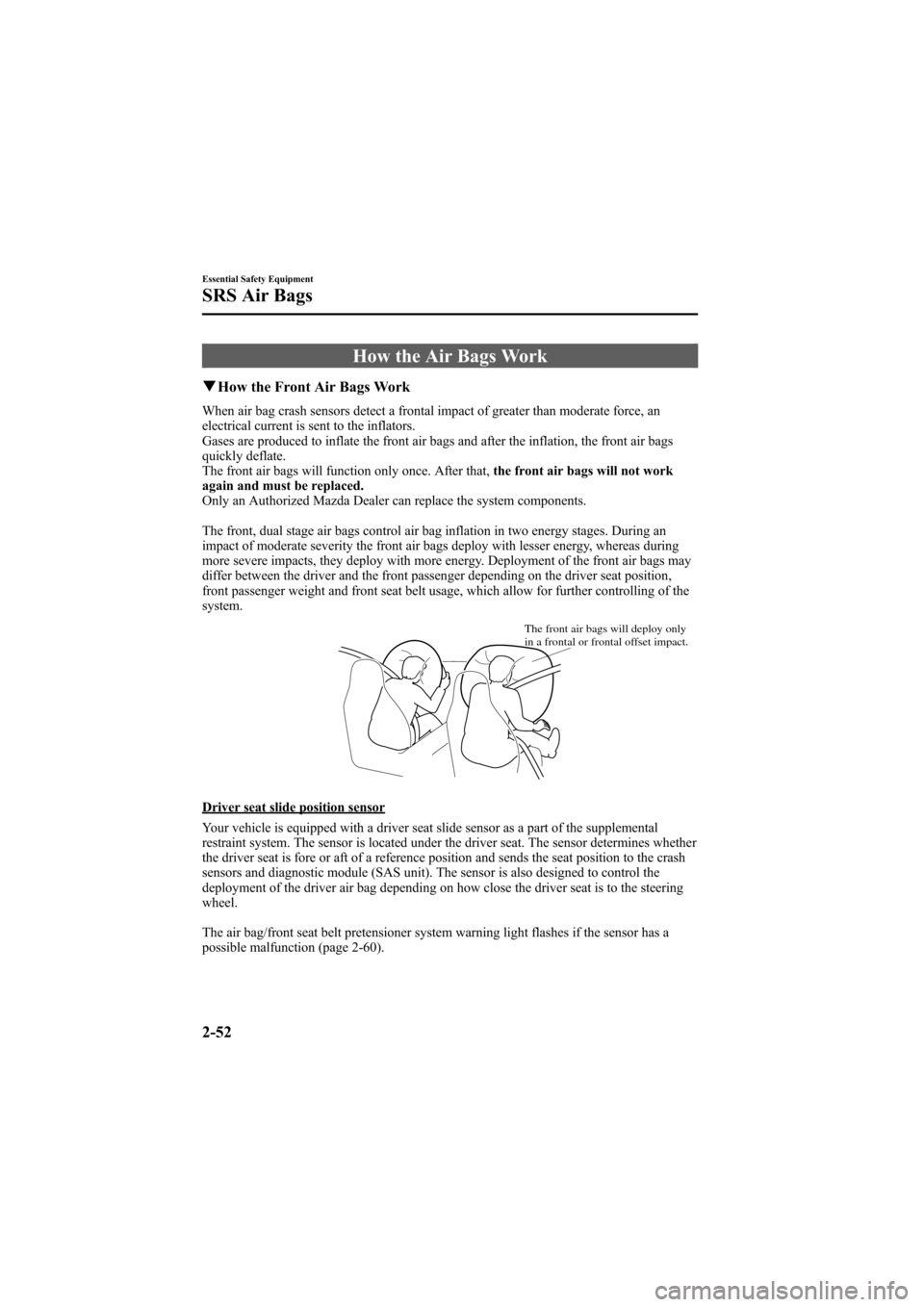
Black plate (66,1)
How the Air Bags Work
qHow the Front Air Bags Work
When air bag crash sensors detect a frontal impact of greater than moderate force, an
electrical current is sent to the inflators.
Gases are produced to inflate the front air bags and after the inflation, the front air bags
quickly deflate.
The front air bags will function only once. After that,the front air bags will not work
again and must be replaced.
Only an Authorized Mazda Dealer can replace the system components.
The front, dual stage air bags control air bag inflation in two energy stages. During an
impact of moderate severity the front air bags deploy with lesser energy, whereas during
more severe impacts, they deploy with more energy. Deployment of the front air bags may
differ between the driver and the front passenger depending on the driver seat position,
front passenger weight and front seat belt usage, which allow for further controlling of the
system.
The front air bags will deploy only
in a frontal or frontal offset impact.
Driver seat slide position sensor
Your vehicle is equipped with a driver seat slide sensor as a part of the supplemental
restraint system. The sensor is located under the driver seat. The sensor determines whether
the driver seat is fore or aft of a reference position and sends the seat position to the crash
sensors and diagnostic module (SAS unit). The sensor is also designed to control the
deployment of the driver air bag depending on how close the driver seat is to the steering
wheel.
The air bag/front seat belt pretensioner system warning light flashes if the sensor has a
possible malfunction (page 2-60).
2-52
Essential Safety Equipment
SRS Air Bags
Mazda6_8T56-EC-04G_Edition2 Page66
Monday, November 15 2004 4:32 PM
Form No.8T56-EC-04G